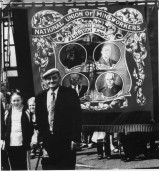
Bands and Banners
Summer 2000 N0.6 £1.95

When Dave gave me his copy of Bands and Banners and suggested I write a review, I must admit I was a bit nonplussed as to what I, a Yorkshireman, would find of interest in a publication from the Durham Area of The National Union of Mineworkers. Having just finished reading the magazine from cover to cover, I can only say how pleasantly surprised I was.
The cover of the publication carries a full page photograph from this year’s Durham Gala, and this is where I find my only criticism of what is otherwise an excellent and well presented magazine. Printed on high quality glossy paper throughout, one would expect to find more superb colour photographs inside. Instead they have chosen to present only five colour photographs, including the cover, out of the thirty five photographs published. I assume this was done in effort to keep printing costs down, but it seems a pity to have a report on an event as vibrant and colourful as the Durham Miners Gala illustrated in black and white.
That minor criticism aside, the report on the Durham Gala, or the Millenium Gala as it is referred to at the start of the report, is extensive and informative. The Bands and Banners editorial on the first page tells us that the police estimate for participants in the event was 50,000. A shame then that, as the editorial tells us, it’s been 14 years since a leader of the Labour Party attended the Gala.

Happy faces at the Gala
The report on the Millenium Gala says that this year’s Big Meeting
was the biggest and best for years. Thirty six brass bands and over one
hundred trade union banners took three hours to travel the parade route,
and this after the whole event looked so doubtful due to the Durham Area
NUM’s lack of funds in February. The report says a campaign was launched
to save the Gala, with the results that the Gala has been made safe for
the foreseeable future.
The list of speakers who attended the Gala includes Tony Benn, Alan Simpson
MP, Inez McCormack - President of the Irish Council of Trades Unions and
Secretary of Northern Ireland Unison, Rodney Bickerstaff - Unison General
Secretary, and the award winning journalist John Pilger.
Anyone who lived through the strike of ‘84-’85 will remember
how John Pilger supported our cause. While other rags were calling us
everything from "sheep" to "scum", his supportive
articles in the Daily Mirror, The Guardian and The New Statesmen played
an important part in our struggle.
The moving and passionate speech he made at the Gala is printed in full,
taking up pages five and six of "Bands and Banners"
Following another collection of Gala photographs from Keith Potts, there’s chapter five of Ned Cowen’s "Of mining life and aal it’s ways" His memoirs of being a union official in the 1930’s is enthralling and fascinating. Sprinkled with dry humour and wit, he tells a story of the dark days of mining when strikes and stoppages were commonplace due to the antics of overzealous colliery officials. With a boat race on the Tyne and fish and chips with Ellen Wilkinson of the Jarrow Crusade thrown in, his story makes absorbing reading.
The centre pages of Bands and Banners are taken up with an article
about a local artist, (well, local to us Doncaster folk anyway!) Janet
Buckle.
Born in Bradford in 1945, Janet attended the Slade School of Art in London
from 1965-69. After qualifying as a teacher she taught art at Dunfermline
High School for a year, before returning to Yorkshire to teach at Rossington
near Doncaster.

The article is illustrated with four colour photographs of her work, showing how she was influenced by the industrial scenes of the Doncaster coalfield.
"Epitaph for a pony" by Tom Lamb is a sad and moving tale about a Somerset born Bevin boy called George. George shows his unashamed grief at the loss of a befriended pit pony called Tramp, after Tramp had been killed in an accident. Actually, this story is a bit too soppy to be taken seriously, (at least for us Yorkshire grit types).
"I Believe" is a story by Lewis Burt, a prize winning
essay writer from Ellemore colliery.
This, his final essay before his death in December 1969, is a story about
a man who is befriended by Romanies after a helping a gypsy boy who had
been gored by a bull.
After the Dear Editor page, comes our own Dave Douglass’s obituary to his comrade Peter Elliott. You can read this in full on our News page.
Bands and Banners finishes with Richard Richardson’s tale of the hardship endured by his father and many other miners after the end of the 1926 strike. Because he stood out against the coal owners, Richard’s father was blacklisted. The militant miners of Thorne Colliery near Doncaster were scattered all over the country. A Journey to Kent 1926 tells how Richard's family moved to Kent with the help of The Salvation Army, so that his father could find work at Snowdon colliery and provide a fresh start in life for his wife and four children.
So to finish. When I first picked up Bands and Banners I had expected to find another political pamphlet. What I found instead was an interesting and entertaining magazine which I would recommend to anyone interested in finding out more about mining lore and miner’s lives. Filled with anecdotal articles which are sometimes humorous, and witty, other times touching and serious, Bands and Banners makes for a really good read.
Adge.

Bands and Banners is published quarterly by the Durham Area, National
Union of Mineworkers. in associatian with Trade Union Printing Services.
ISSN: 1466 - 1365
Annual subscription rates £10 per year inc p&p (four issues).
Send cheque payable to Bands and Banners to PO Box 6, Red Hill, Durham
DH1 4BB